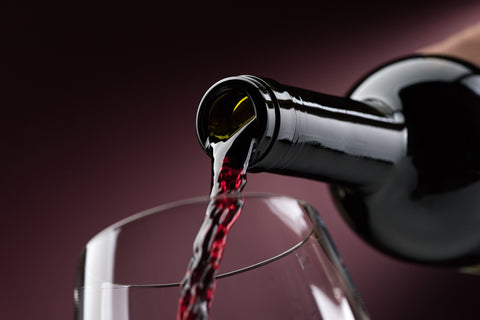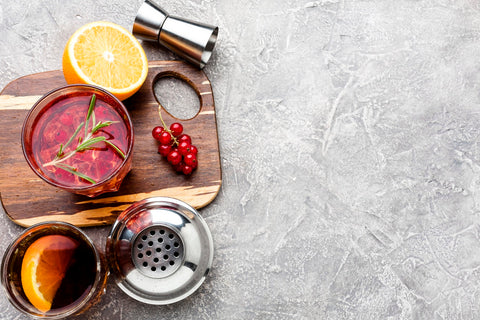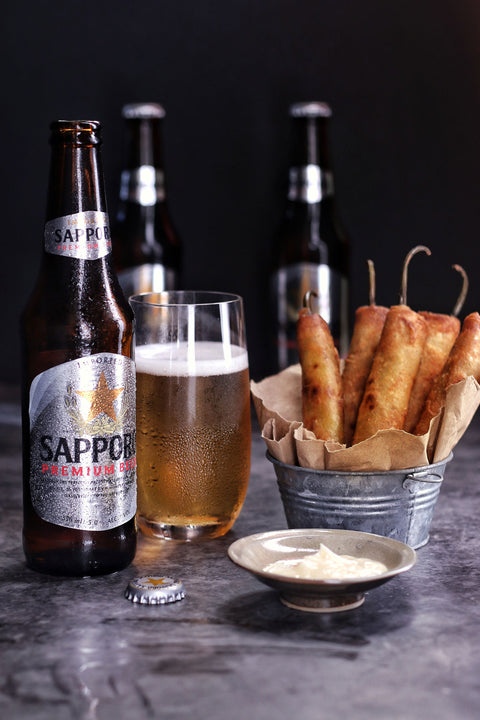What are the basic types of wine?
- Red Wine
- White Wine
- Sparkling Wine
- Rosé Wine
- Dessert Wine / Fortified Wine
Wine has a complex character, and learning its nuances can help you better appreciate this drink. In this article, we discuss a basic yet fundamental topic: the five primary types of wine. Understanding the features of each type will help when you begin to delve into the intricacies of wine.
Red Wine
The first and most obvious characteristic of this wine is its color — it ranges from pale ruby to a deep, opaque purple. The second is its tannins, which it gets from a method called whole cluster fermentation. The longer the skins, seeds, and stems soak, the more tannin characteristics they will impart. This is why red wines have stronger, deeper, and drier profiles than other wines.
Light-bodied red wine

This style is much lighter in tannins, so this is a good choice for people trying out this type for the first time. They are less dry, and more fruit-forward — making them easier to drink. Their main flavors include cranberry, cherries, and blackberries. They typically taste well with cured meats and fresh and bloomy cheeses.
Examples of Light-Bodied Red Wine:
- Pinot Noir — For the most popular light-bodied red wine, we recommend getting the Monet Alpha Pinot Noir for its elegance and complexity.
- Zinfandel — despite being light-bodied, Zinfandel wines like Foppiano Estate’s and Wente’s contain intense aromas and flavors of berries and spices.
Medium-bodied red wine

Offering a ton of flavor with decent acidity and tannin levels, this type matches with a wide variety of foods — not just red meat! You can enjoy this type of wine with earthy cheeses and salads as well. Most red wines fall into this category, and have prominent flavors of plum, cranberry, blackberry, and even cured meat.
Examples of Medium-Bodied Red Wine:
- Merlot — The benchmark example of a medium-bodied red wine, it has a standard profile of red fruits, velvety mouthfeel, and mild tannins. We suggest trying the Montes Alpha Merlot if you enjoy toasted notes and a floral bouquet with your wine.
- Cabernet Franc — Spring florals, exotic spices, and hints of smokiness make a wine like the Chateau Bernateau Grand Cru a remarkable Cabernet Franc.
Full-bodied red wine

This is what comes to mind when most think of “red wine.” They are high in tannins, deep in color, and are strongly flavored with notes of dark berries, cedar, currant, and tobacco. They go great with any meaty and rich dishes, but can also be enjoyed alone. While newer drinkers may need some time to get used to it, you’ll be sure to love the depth and complexity of this type.
Examples of Full-Bodied Red Wine:
- Cabernet Sauvignon — A bottle of wine with beautifully balanced dark fruit and oak flavors that only get better with age, the Francis Ford Coppola Diamond Collection is our pick for those with mature tastes.
- Malbec — Searching for some wine to pair with your steak and pasta? Try the Trapiche Broquel Malbec — its robust and spicy palate with a pleasant finish is the ideal pairing for rich dishes.
White Wine
Unlike red wines, white whites are made by removing grape skins before fermentation — yielding a clearer drink. Under this change, reds and whites exhibit differing profiles. Although it’s hard to generalize, reds have flavors reminiscent of berries, spices, and earthiness. Whites on the other hand are known for their lighter, brighter expressions of citrus fruit and floral aromas.
Light-bodied white wine

For many beginners, this type is the go-to. They are dry and lightly crisp wines that are easy on the mouth. This quality makes it easier for less-experienced drinkers to enjoy. While the flavors vary depending on the bottle, they typically include hints of citrus and fruit — such as apple, grapefruit, and melon. This type of wine is best drunk while young, and goes great with nutty cheese, fresh herbs, shellfish, and mollusks.
Examples of Light-Bodied White Wine:
- Sauvignon Blanc — For Sauvignon Blanc, the Sirius Bordeaux Blanc is one to try. It’s zesty, mildly textured, with notes of tropical fruit and cinnamon. Delicious!
- Pinot Grigio — Looking for a fresh and clean wine? Try the Bolla Pinot Grigio Delle Venezie. This one has delicate flavors of peach, melon, pear, and lime and a crisp finish.
Full-bodied white wine

If you love red wine but are a beginner at whites, then this type is for you. They go through special techniques to develop their flavors, such as oak barrel aging or a second fermentation. They typically have a subtle creaminess to them, and flavors of apple, honeysuckle, and tropical fruit. They pair with the widest variety of food out of all white wines but are especially delicious with white meat, finfish, and roasted dishes.
Examples of Full-Bodied White Wine:
- Chardonnay — The classic choice of full-bodied white wine, check out the Wente Morning Fog Chardonnay for a well-aged and beautifully balanced option.
- Viognier — For wine lovers who love to eat rich seafood like shrimp and salmon, the bold and acidic Yalumba Y Series Viognier might appeal to your tastes.
Sparkling wine

These are carbonated wines, hence their nickname “bubbly.” They can be made with any grape variety, and are the most challenging and time-intensive types to make. Their main flavors include citrus, toast, and peaches. They pair well with a wide variety of shellfish, green vegetables, and cheeses.
Examples of Sparkling Wine:
- Champagne — we recommend trying the Champagne Marguet Shaman Brut Grand Cru for its complex characters and well-balanced palate.
- Prosecco — for beginner wine drinkers, this Romio Prosecco is a good drink to enjoy at dinner. With its fruit-forward and zesty taste, it pairs nicely with salmon and shellfish.
- Cava — hailing from Spain and made in the traditional method, it is known for its faint floral aromatics and acidic brightness. For this type, we recommend trying the Freixenet Negro Brut.
Rosé Wine

Rosé is a type of red wine that was made like white wine. Its juice only sits with the grape skins for a short period, allowing only the slightest bit of color and tannin to seep in. Most Rosés have pronounced fruit flavors and can be made from a variety of red grape varietals. They are great when paired with pasta, cheeses, and cured meats.
Examples of Rosé Wine:
- Tempranillo Rosé — Want to try something bubbly, sweetly textured, and refreshing? Then try Provetto Spumane Rosato Secco, a delicious sparkling Rosé.
- Pinot Noir Rosé — Want something with a more intricate blend? Check out Moët & Chandon’s Rose Imperial, made from Pinot Noir, Pinot Meunier, Chardonnay, and reserve wine.
Dessert Wine / Fortified Wine
Some people get confused between dessert and fortified wines — it’s easy to assume they’re the same as they are both heavy and sweet. However, fortified and dessert wines are two completely different types of wine made from distinctive wine-making techniques.
Dessert Wine
Some of the boldest, most intensely flavored wines you can find are dessert wines. Dessert wine-makers use various methods to enhance the sweetness and don’t use added alcohol to achieve their profile. With their caramel, stone fruits, and brown sugar flavors, a good dessert wine is a great way to finish off a meal.
A popular dessert wine is Eiswein, literally meaning "ice wine," made in Germany and Austria. It features Riesling grapes that have frozen on the vine — which concentrates its sweetness and acidity. Another is Sauternes, which comes from a French region of the same name. It is a very sweet white wine, made from Sémillon and Sauvignon Blanc grapes affected by noble rot.
Fortified Wine

Unlike dessert wine, fortified wines are made using added alcohol — typically brandy or a neutral spirit. A fortified wine’s flavor profile changes depending on when the winemaker adds the extra spirit. If added after the fermentation process is complete, it becomes sweet. If added beforehand, it becomes drier. This type also tends to be higher in alcohol — anywhere from 17 and 22 percent. It’s a very heady style of wine.
Port, Sherry, Madeira, and Marsala are the four main types of fortified wine. And like many things, some fortified wines just get better with age. Take, for example, the Ferreira Duque de Bragança. It is a marvelously made 20-year-old port with a sweet and intricate bouquet of nuts, spices, dried fruits, and marmalade.
Key Takeaway
Understanding the different types of wine is a great starting point for those looking to try wine, but don’t know which kind to get. Whether you’re looking for your go-to wine or love experimenting, Ralph’s Wines & Spirits is here to provide a wide selection of different varietals, origins, and wineries to satisfy even the most discerning palate. Check out our collection here!



